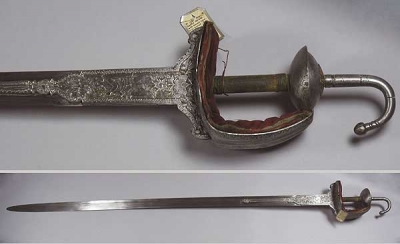Sukhela (1935.48.11)
 IndiaSukhela from India, Asia. Owned by the Maharaja of Jaipur. Transferred to the Museum from the Indian Institute in 1932.
IndiaSukhela from India, Asia. Owned by the Maharaja of Jaipur. Transferred to the Museum from the Indian Institute in 1932.
This sword is known as a sukhela and it was probably made in Rajasthan in northern India in the 17th century. It is in fact a type of khanda, the traditional sword of Hindu India, but has a pointed rather than traditionally squared-off tip and has a velvet-padded counterguard and hooked pommel.
The Marathas in the south, who disfavoured curved blades, introduced the sukhela khanda but such Indian straight blades were still intended for cutting unlike in Europe where they were used for thrusting. The very thin, flat steel blade often has reinforcement langets on the area near the hilt to counteract its extreme flexibility. This combination of a flexible blade and inflexible reinforcement plates creates a weapon that will withstand impact without bending out of shape and will not chip nor shatter easily.
The blade is probably European, since sukhelas were also commonly known as firangi, meaning 'foreigner'. This name was also given to any 17th century Indian sword mounted with a valuable European blade.
Sacred Weapons
The khanda is a weapon of considerable cultural and religious significance in India. This form, the sukhela, being a sword of state, is also important in affairs of court. In Moghul paintings it is shown worn by courtiers or bestowed as a gift by the Emperor. Also, the engraved reinforcement langets along the back of the blade are fretted in a similar way to the architectural detail of Rajput palaces, such as those in Jaipur, Jodhpur, and elsewhere.
The khanda plays a central role in the nine-day Hindu festival of Nauratra in Rajasthan and other Rajput areas. Nauratra glorifies the war-goddess Durga and the war-god Shiva, who are seen as wife and husband in some branches of Hinduism, though not in others. On the fourth day of Nauratra, the Rajput prince goes in procession to his local chaugan, a grassed ceremonial ground, where he oversees the slaughter of a buffalo. Then he proceeds to the Temple of Durga. Here, he performs Kharga Shapna, 'The Imprecation of the Sword', where he worships the khanda and the standard of the Raj Jogi, the high priest of Shiva. In this way, the prince pays homage to Shiva and Durga, making offerings of sugar-water and rose-garlands. Having performed this devotion, the prince leaves the temple and proceeds to a nearby location, where a second buffalo has been staked. He ritually sacrifices this animal by shooting it with an arrow.
The khanda also has great cultural significance for Sikhs, and the chosen symbol for Sikhism is known by that name. This khanda symbol comprises a khanda sword in the middle, surrounded by a chakram (a circular war quoit), and two crossed, curved daggers known as kirpans. For Sikhs, the khanda sword symbolises knowledge of God and the twin dagger blades symbolise the fusion of military and religious qualities, which historically came to be a necessary characteristic of Sikh culture in the face of Mogul persecution.





